Girls as young as fifth graders are getting more and more into the tech and robotics industry in Estonia, shifting the stereotypes according to which this field of study is only meant for boys and men.
A small school in Voore (part I)
The sun brightens up the day,
The moon shines in the night,
Rather tiny in my way,
But I have a lot of might.
Many of those who grew up in the Soviet-era Estonia may remember this catchy song from a 1970s cartoon and kids’ book, “The Happenings of Atomic”, about a tiny particle that escapes the lab it was created in and starts to make things happen.
For some reason that happy song of the tiny but mighty character started to loop in my head when I was recently visiting a small school in Voore, near the Lake Peipus, on the eastern verge of central Estonia.
The name of the village implies to the word “voor”, a drumlin, an elongated hill that was shaped by glacial ice thousands of years ago. If you stood on top of one of those drumlins, you could admire a magnificent view. It looks as if some sort of a giant left hundreds of half-buried eggs hatching in the ground in each direction. Of course, there was no mythical giant but the miracle was created by melting ice, leaving behind this most peculiar landscape that is both pleasing to the eye as well as evoking to the fantasy.
Last year it inspired three local school kids to come up with an idea to build a viewing tower near their home village as a gift for the 100th anniversary of the Republic of Estonia. Liisa-Marie, Kaila and Emil, who were fifth graders at the time, made a 3D model of the tower, printed it out and won the first prize on national digital projects competition.
Bitten by a tech-bug
“Our math teacher told us there will be a national competition coming up that also includes a 3D section,” the young engineers tell me a year later. “We thought about it a lot and decided to do something useful for our local municipality.” Therefore they decided to design a tower that would offer the locals an opportunity to admire their beautiful surroundings, but also attract more visitors to Saare parish, an area out of reach of the regular tourist trails.
Liisa and Kaila were searching the map of the national Land Board until they found the highest peak that is more than a hundred meters above sea level (which is high in Estonian terms!), on top of Kallivere drumlin. Emil, who loves to take pictures, caught the spot with his Canon camera in wintry conditions – the white snow is contrasting with the dark forest on the background, underneath an overcast blue sky. This is probably not a coincidence that the picture reminds the viewer of the blue-black-and-white tricolour flag.
The teachers praise Emil for always being the fastest to finish his games in the robotics class. Asking him if he already knows what he will study in the future, he does not hesitate for a second: he wants to follow in the footsteps of his older brother and continue his education at Luua Forestry School.
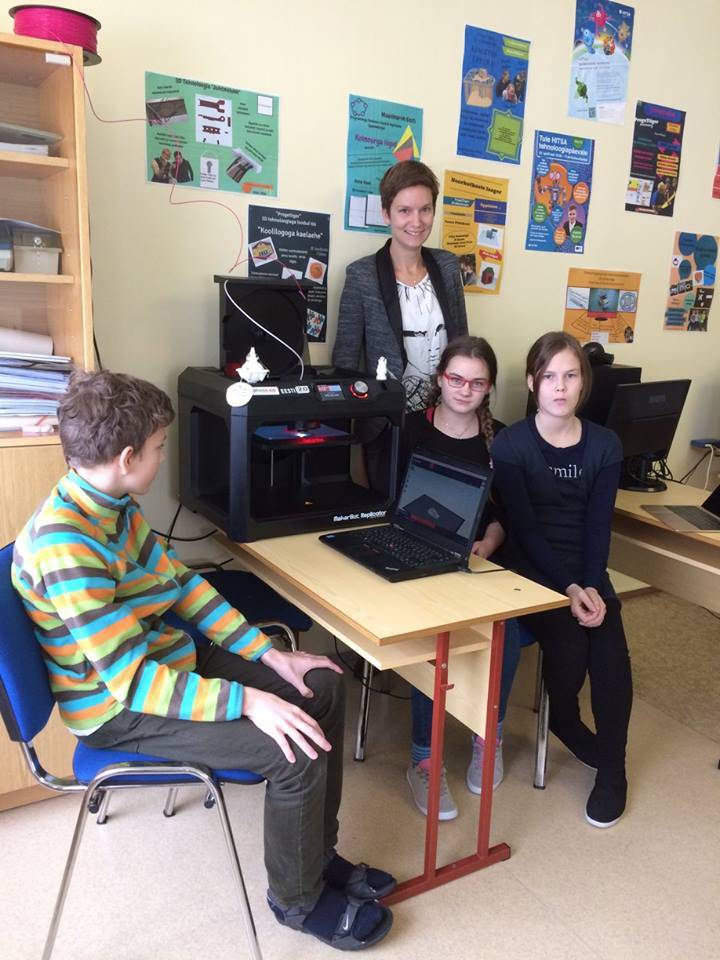 Liisa-Marie, who is the most outgoing of the trio, has also made up her mind about her future: she wants to go to high school in Jõgeva (also following the example of an older sibling) and then, who knows, maybe defy the stereotypes and go study IT in university.
Liisa-Marie, who is the most outgoing of the trio, has also made up her mind about her future: she wants to go to high school in Jõgeva (also following the example of an older sibling) and then, who knows, maybe defy the stereotypes and go study IT in university.
Robotics class is one of her favourite classes, in tight competition with arts and physical education.
An ordinary day for the 12-year-old Liisa-Marie starts at 7:30 AM when she boards the school bus in her home village of Ruskavere, 10 kilometres (six miles) from Voore. She then takes her five-year-old sister to the daycare and will be at school in time for the classes to start at 8:30.
“What I like most about our school is the fact that everybody knows everyone’s name and what grade you are in,” tells Liisa. There are 49 students in Voore middle school.
3D gurus
Shortly after a lunch break the sixth graders – all nine of them! – are sitting in their computer lab for a math class. There are two teachers to tutor the students but everyone seems to be well aware what they are doing and working in complete silence. They are using Tinkercad, an easy-to-use 3D modelling program for beginners, to draw geometrical shapes to create animals that they have already drawn on paper beforehand. Once they have finished their 3D-models, they will print them out.
In the beginning of the 2015/16 school year, Voore school was one of the 50 schools in Estonia to receive a 3D printer from a pilot project of Eesti 2.0, a non-profit organisation that aims to inspire the next generation of Estonians to choose a future in technology. At the end of the school year the whole school participated in the national science fair type of contest “World Country Estonia”, organised by the Information Technology Foundation for Education (HITSA).
“We just wanted to participate and not go for the win,” the math teacher and 3D tutor, Mare Maasik, says modestly. But she confesses she was shaking all over when the news came that most of her students had made it to the finals. As is a tradition in their school, everyone took part and everyone got to go to the finals in Tallinn. They were overjoyed to bring home almost all the prizes in their age groups.
Half a year later they were awarded the first prize for the “Most Entrepreneurial School” contest in Pärnu for their case study of “Using 3D modeling, 3D printing and programming in the learning process”.
It seems obvious that the key to success is the tight-knit community of the small school. “Because of our small size, everyone will take part in everything we do,” the computer class teacher, Kaie Mikko, claims. So it was no longer a surprise to the organisers of a recent contest of 3D Christmas decorations that every third participant to the competition came from the tiny Voore school.
Small but feisty
After receiving nation-wide praise, Liisa, Kaila and Emil went to present their idea to the local municipality. Their presentation was well received but nothing much happened afterwards. It is likely that their great idea was overshadowed by the recent land reform which encourages all smaller local municipalities to join into units of no less than 5,000 inhabitants. Saare parish will merge into a neighbouring Mustvee parish. The biggest town nearby is Jõgeva, but when the locals say, “I’ll go to the town”, they are referring to Tartu, which is a 40-minute drive away. And they will have to drive their cars since there is no train or a regular bus to take you there.
As a silent observer of all the good times and bad times that this little village has seen, there stands a corner tower of Roela manor house, now almost completely overgrown by big trees. Looking for references, one will be directed to the local paper “Vooremaa” that published a story on a battle that took place just less than an hour in the summer of 1941 between the incoming Germans and the retreating Red Army that completely ruined the old manor. What was left of the buildings was later demolished by the Soviet system.
But something good also came out of that era: shortly before Estonia regained independence, a new school was built to Voore in 1989. Facing a scarcity of resources – like most schools in Estonia –, the staff has been more keen on advancing its technological prowess than updating other amenities.
The school obtained new computers last spring and the robotics class – being the most popular after school activity – has almost everything a school can think of, from littleBits blocks to Lego constructors. The teachers will not be taken back by the fact that sometimes their students are far more tech-savvy than they are since the kids have a far more intuitive approach to new technologies than those from previous generations.
School principal Raivo Reimets, a physics and technology teacher, is well aware that a large variety of tech options will spark further growth. “The kids want to see results fast and robotics class will give you an excellent opportunity to build something that moves around in just an hour,” he says.
Seeing the school investing in technology makes me wonder if they will be able to celebrate its 30th anniversary in style, a year after the centennial anniversary of Estonia. It’s not just the case of Voore, but many small schools in more remote parts of the country are in limbo due to constantly diminishing student numbers and less support by state institutions. The principal does not want to elaborate on these matters and only refers to the school motto which goes, “I will be better today than I was yesterday!”
A robotics club on the outskirts of Tallinn (part II)
I’m reminded of the mighty Atomic again when I enter a small house in suburban Laagri, in a quiet dead-end street on the outskirts of Tallinn, 200 kilometres (125 miles) north-west from Voore. Opening the door I’m greeted by a flush of smell of fresh dumplings as well as high-pitch noise. The room is full of girls who all talk instantaneously to one another and move around so fast that the first impression of the sight makes me feel slightly dizzy.
Settling down, I understand this is no ordinary playdate of a group of friends, although it is obvious that the youngsters are all good friends. It’s actually a regular meetup of a robotics club team to practice for the finals of the First Lego League (FLL) Estonian finals (that were held in Tartu in early March). It’s probably no coincidence that out of all the 37 teams participating in the finals both girls-only teams are from Laagri.
Brigitta, Norah, Mirjam and Karmen are best friends since kindergarten and being third graders now, it’s their second year taking part of the FLL robotics competition. Although the official rules would allow them to start competing this year as they are nine years old. Last year they were part of a boys/girls mixed team called “Laagri Garbage Heap Monsters” with Mirjam’s twin brother Oliver and his classmates and a few older friends who were in charge of building the robots.
This year they decided to go for a girls-only team and Aimei, Grete and Viivian also joined in. The seven members took a vote on the new name and it was decided it will be “Laagri LaTüü”: an Estonian/French version of “Cool Girls from Laagri”.
Why do they like robotics and why did they pick such a name for the team?
“Because we love to compete and beat the boys!” a well-coordinated answer comes instantly.
Mirjam’s brother Oliver will have to admit that LaTüü has indeed beaten his team, “The Sandwich Aces of Laagri” since they did not make it to the finals. “The boys took far too many risks,” the girls say. Nevertheless, Oliver is adamant that he is not envious of his twin sister since he can now spend more time on his other hobbies instead of prepping for the finals. Nevertheless, he has agreed with his friends that they will participate in Robomiku, yet another Estonian robotics competition held in April.
Computers on the dancefloor?
Being successful in Lego League is a result of a mix of components. While building, testing and programming autonomous robots using Lego Mindstorms EV3 robots to solve a set of missions on an obstacle course like saving a shark from a cage, taking a bumble bee to the beehive or turning on the milking machine, the teams will also earn points for their creativity, teamwork and core values. The latter will be expressed in a “value proposition”: in LaTüü’s case it’s saving the koalas by building shelters for the cute marsupials.
“We decided that everyone picks an animal and then we vote. Koalas won,” the team explains enthusiastically. It does not really matter that koalas only live in Australia, they are an endangered species and the girls want to follow the golden rule: think globally, act locally. “Their homes and sole sources of food, eucalyptus trees, are being chopped off and burnt down fast and soon they will run out of food.” The girls have done their homework well; they have even found an unbelievable factoid that koalas are good swimmers.
LaTüü has built a model for a koala shelter where people, not animals are the ones to be fenced in. They have made themselves costumes that accompanied by fitting face paint and hairstyle will make them look like marsupials themselves, although unusually fast-moving and talkative ones. They have also prepared a video that they will play for their audience in the finals in the Estonian National Museum in Tartu.
The editing was done by Viivian, the oldest member of the team. “I got this new app called Filmora,” she shows me on her computer screen and counts a list of famous youtubers she follows and would like to invite to make a guest appearance in one of their upcoming videos. Last year they made a promotional video with a band called La La Ladies where LaTüü was teaching the singers how to “do a mission”, ie solve the challenges on a robo-trail. “So the girls could also be wiser and be better than boys,” Brigitta sums up at the end of the video why the girls should attend robotics classes.
Although LaTüü has more than proven the point in less than a year, the wider problem does not seem to be disappearing. “My niece just dropped out of robotics club because she could no longer resist the boys solving all the challenges for her,” Viivian is disappointed.
Several teachers have pointed out and the surveys also support the fact that although girls start robotics classes with the same amount of enthusiasm as boys do, most of them just seem to disappear at some point, usually in the fourth to sixth grade. Robotics is somehow still considered to be “a boys’ activity” while according to “common sense”, the girls are expected to take up something “more girly” like dancing or singing despite the fact that all of these activities could well be combined and enjoyed by both genders. The members of LaTüü team count the list of extracurricular activities they participate in besides the robotics club: ceramics, show dance and woodwork.
The truth is that most of these stereotypes only exist in our heads, mostly the heads of the previous generation. A survey conducted two years ago by the team of researchers at Tartu University, by request of Skype Microsoft Estonia, revealed that “the capabilities of boys and girls in sciences and technology are not gender-based but mostly constructed by the conditions created by parents, schools and society which will enforce girls to work twice as hard to reach their full potential and prove their worth” as “parents would rather expect their sons to choose a future in science, technology or mathematics” (“The role of women in Estonian ICT sector and the opportunities to change it”, 2015).
To prove the point: despite the fact that in the earlier version of the kids book Atomic was depicted as genderless metallic particle, in the 1980s version he becomes a human being with distinctive boyish features (not to mention that the scientist working in the lab is an elderly white man).
Myth busters
Although the myths will take a long time to disintegrate, there are parents who dare to think “out of the box”. The Laagri robotics club came to be thanks to one parent who would not take “no” for an answer. Diana Poudel has been active in Saue parish for years, and she also happens to be the mother of the twins Mirjam and Oliver. “It seemed easier to start this thing here than keep driving my kids someplace else,” she claims. “Robotics is so much more popular among kids as compared to regular programming because it makes things move around. It is far more attractive to kids and they can start learning as early as in kindergarten. There will be no fields of life where you cannot use this know-how in 20 years.”
Diana was in charge of organising a trial class for robotics that ended up collecting €5,555 instead of the €4,000 they pledged for on Hooandja, an Estonian crowdfunding platform. The Laagri robotics club was kicked off with eight teams in early 2015. There was such a keen interest that the last ones on the waiting list were only accepted in the beginning of this year. Now almost every fifth pupil in the school of more than 700 is a member of a robotics team.
Only a year into starting with robotics, Laagri was already a well acknowledged member of the vibrant school robotics community in Estonia. Their teacher, Mai Pitsner, was awarded the best tutor in FLL last spring and the club was chosen as the best newcomer in Robomiku contest. This year, Laagri school hosted one of the North-Estonian semi-finals for the FLL. Out of all 111 teams participating in three semi-finals there were four teams from Laagri.
It’s not just about the gadgets that the school has purchased, starting from easier Beebots and Ozobots to more complex Lego WeDo’s and Mindstorms to Arduinos. The people committed to the cause are a far more valuable asset. It’s not easy to find a good robotics teacher, but Laagri is lucky enough to share their teacher Mai with two other schools.
“Mai is the best teacher,” LaTüü members tell me with great pride. “She’s not just a robotics teacher, she has also written a book!”
It’s rather obvious that one person is not enough to help all teams in their preparation for big competitions. This is where the parents come in handy, helping out with everything else besides the robo-race. Diana is one of those parents who host a team meeting in her house once a month to help the team practice their moves, both on the race course as well as on the stage. The girls are not afraid to be the youngest team to compete in the finals where some teams consist of 16-year-olds. The only other team they really look up to are the “Owls who are really-really smart!”
“We have our own robotics anthem,” the girls declare. “And if we get an award in the finals, we will have a movie night with popcorn!”
I
Cover: LaTüü members at First Lego League (photo by Viorica Bordei.) Please consider making a donation for the continuous improvement of our publication.

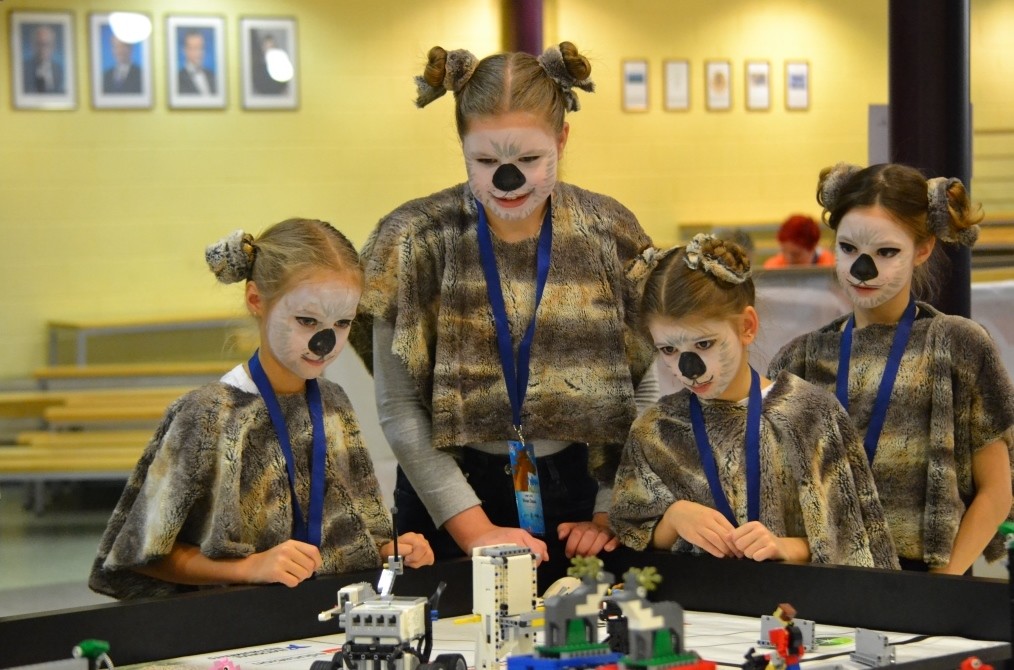
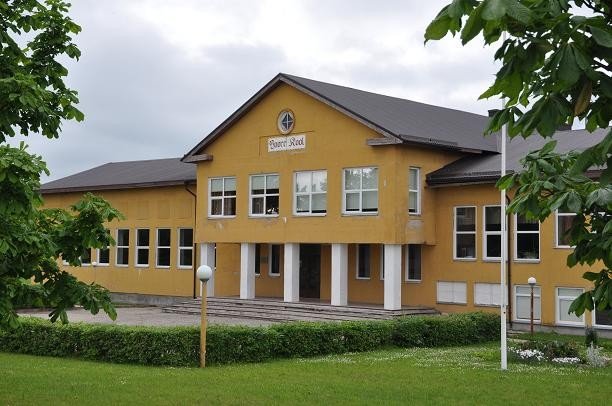
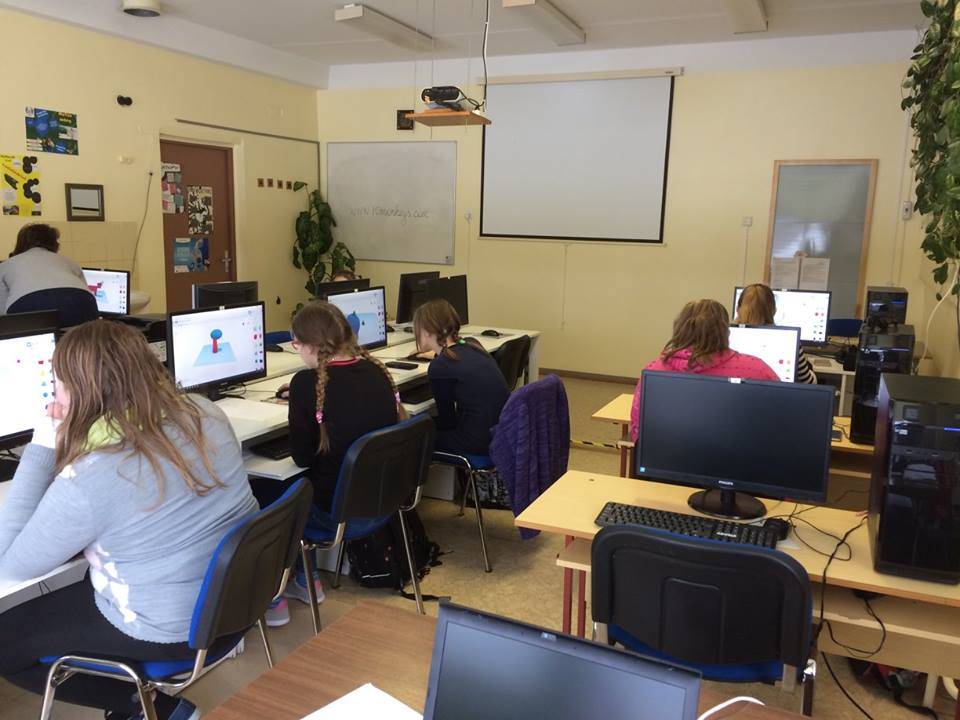



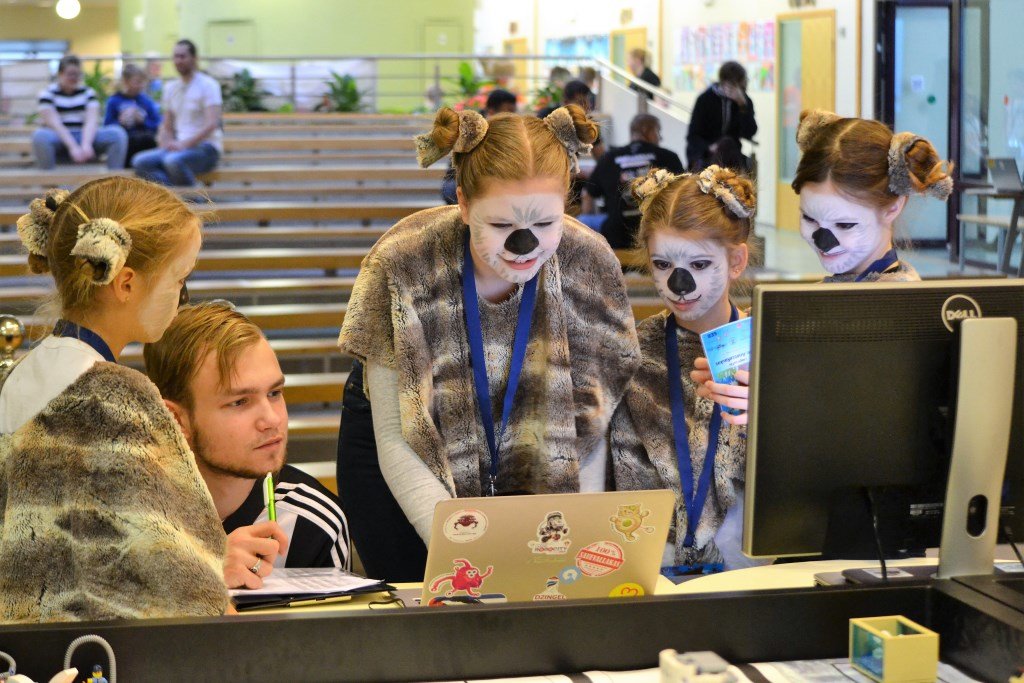


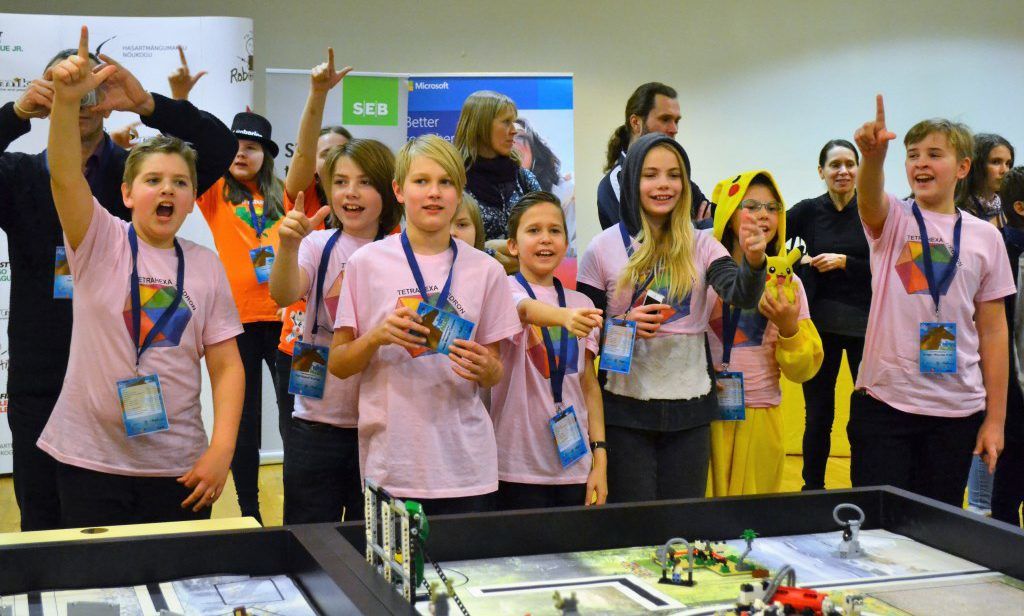
Beautiful, I am reading about “e-Stonia” in my country Honduras (Central America), is an amazing story, I am sure that we can learn a lot from it.